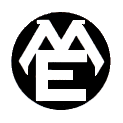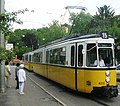Machine factory in Esslingen
| Machine factory in Esslingen
|
|
|---|---|
| legal form | Corporation |
| founding | March 11, 1846 |
| resolution | 1968, formally 2003 |
| Reason for dissolution | Takeover by Daimler-Benz in 1965 and subsequent integration into the company, floor conveyor division in Still GmbH |
| Seat | originally Esslingen am Neckar , most recently Schönefeld , Germany |
| Branch | Traffic and vehicle technology , mechanical engineering |
The Maschinenfabrik Esslingen AG (ME AG) , also Maschinenfabrik Eßlingen AG , was a company for the production of locomotives , railcars , trams , aircraft tugs , funicular railways , railway wagons , trolleys , railway equipment ( turntables , transfer platforms ), bridges , steel structures, pumps and boilers .
Most of the ME AG shares went to Daimler-Benz AG in 1965 , while conveyor vehicle production went to Still GmbH in 1968 . ME AG was just a real estate and rental company. In January 2003, the minority shareholders were paid out as part of a squeeze-out .
history
The engineer Emil Keßler , born in 1813, founded the machine factory on March 11, 1846 in Stuttgart ; This was preceded by an initiative by the Kingdom of Württemberg to create a railway industry that was independent of what was then abroad. Keßler brought relevant experience with him from Karlsruhe , where he was co-owner from 1837 and sole owner from 1842 of the mechanical engineering company in Karlsruhe .
The foundation stone of the new plant in Esslingen am Neckar was laid on May 4, 1846. One year later, in October 1847, the first locomotive was delivered to the Royal Württemberg State Railways (KWSt.E.) as contractually agreed. From then on, the machine factory worked closely with the Württemberg state railway, so that almost all of its new developments were manufactured here.
After Emil Keßler's death in 1867, his then 26-year-old son of the same name, Emil Keßler, took over the plant. He managed it until the end of 1885. The thousandth locomotive in 1870 was named KESSLER in honor of the company's founder.
The company gained a very good reputation, initially at home, but increasingly also abroad. Several takeovers of other companies ( Maschinenfabrik Gebr. Decker & Co. 1881, Maschinen- & Kesselfabrik G. Kuhn 1902), the founding of Costruzioni Meccaniche Saronno (Italy) in 1887 and in 1913 the construction of a new factory near Mettingen under the direction of Hermann Maier- Leibnitz testified to the success.
The construction of inland waterway vessels in Ulm and Friedrichshafen, which began in 1851 and was discontinued in 1858, remained an episode, which, however, helped to overcome the economic crisis after 1848. Fifty Danube boats, two Neckard steamers , two bottom steamers ( Wilhelm and Olga ) and two Lake Constance tugs were the result of this activity. The commitment to steel and bridge construction, which continued until the end of the company, was more permanent.
From 1907 a Kessler headed the machine factory again, Emil Kessler's youngest son Ludwig. The company was also involved in the construction of electric locomotives, and the Wendelstein Railway was built in 1912 . After 1920 a program of accumulator locomotives was launched, especially for mine and industrial railways . In addition, vehicles with internal combustion engines were built, as well as Köf small locomotives and the Esslingen railcar . Also in Esslingen, more than 350 examples of the GT 4 tram cars that characterize the Stuttgart cityscape were built from 1956 to 1965, and they were still in use until the end of 2007. The vehicles for the Stuttgart funicular also come from ME. By the 1960s, several thousand steam and diesel locomotives were delivered worldwide, including numerous special designs.
The company acquired a special reputation for building its rack-and-pinion locomotives in many different versions. Among other things, Maschinenfabrik Esslingen, in cooperation with Brown, Boveri & Cie. (BBC) in 1939 for the Otto-Scharf mine in Köttichau , the most modern open-cast mine in Germany before the Second World War, two cogwheel locomotives, at that time the heaviest and most powerful cogwheel locomotives in the world. Furthermore, built the company Zahnradlokomotiven the systems Riggenbach, Abt and Strub. Steam locomotive construction in Esslingen was also completed with such a machine: on October 21, 1966, the last cogwheel steam locomotive built for Indonesia left the factory.
From 1926 to 1963, the Esslingen machine factory also manufactured electrically powered commercial vehicles. Customers included the Deutsche Reichsbahn and later the Deutsche Bundesbahn , where the EK 1002 electric cart used as a baggage cart, equipped with a 2.0 or 2.75 kilowatt motor and one tonne payload, was popular. There was also the EK 2002 with a payload of two tons. The Deutsche Bundespost used the EL 2500 as a parcel post van. The car was built according to plans by the Post and was also manufactured at Lloyd in Bremen and at Gaubschat in Berlin at the same time . A 10.3 kilowatt motor took care of the propulsion and a coal stove served as heating. Other models were the EL 3001, the four- and five-tonner EL 4001 and EL 5001 with a driver's cab of the Daimler-Benz 3.5-tonner. Remaining examples of the electric vans are in the Museum for Communication in Frankfurt, the European Bread Museum in Ebergötzen and the German Museum of Technology in Berlin.
Most recently, ME was a subsidiary of Gutehoffnungshütte . In 1965, Daimler-Benz AG initially acquired 71% of the company in order to use the factory facilities for its production. The production of industrial trucks was sold to Still GmbH in 1968 . The construction of railway vehicles was therefore stopped. The Maschinenfabrik Esslingen AG was then until 2003 a pure property and leasing company as a subsidiary of the Daimler management company for real estate and had its headquarters in Schönefeld .
There is a support association for the maintenance of the locomotives of the Esslingen machine factory .
gallery
Preserved Esslingen locomotive No. 306 from 1856 in the Mulhouse Railway Museum
The mighty Württembergische K is one of the most successful locomotives designed and built in Esslingen
Locomotive No. 103, Bismarck , of the Hessian Ludwig Railway , built in 1872
Type
V 60 diesel shunting locomotive for the Israeli State Railways
literature
- Max Mayer: Locomotives, wagons and mountain railways. Historical development in the Eßlingen machine factory since 1846. VDI-Verlag, Berlin 1924.
- Ludwig Keßler: From the beginnings of the Eßlingen machine factory. Emil Keßler - his life, his work. Maschinenfabrik Esslingen, Esslingen 1938 (memorial to the 125th anniversary of Emil Keßler's birthday, 1938).
- Wolfgang Distelbarth, Joachim Hotz: Emil Kessler. 1813-1867. Exhibition, Karlsruhe, November 4 - December 2, 1967. German Society for Railway History eV, Karlsruhe 1967, (exhibition catalog).
- Wolfgang Messerschmidt: From locomotive to locomotive. Esslingen and locomotive construction for the railways of the world. Franckh'sche Verlagshandlung, Stuttgart 1969.
- Wolfgang Messerschmidt: Locomotives of the machine works Esslingen 1841 to 1966. A chapter of international locomotive construction. Steiger, Moers 1984, ISBN 3-921564-67-0 .
- Werner Willhaus, Jürgen Krantz: Maschinenfabrik Esslingen. ME (= Railway Courier. Subjects. 31, ISSN 0170-5288 ). EK-Verlag, Freiburg (Breisgau) 1999.
Web links
- Machine factory in Esslingen
- Timeline for ME in the 2001 and 2002 editions of the Härtsfeldbahn-Anzeiger
- Friends of ME
- Early documents and newspaper articles on the Esslingen machine factory in the 20th century press kit of the ZBW - Leibniz Information Center for Economics .
Individual evidence
- ↑ www.boerse-stuttgart.de: Announcements (Annex to the course sheet of January 29, 2003), p. 7
- ↑ Karl-Eugen Kurrer : Hermann Maier-Leibnitz (1885-1962): Pioneer of the industrial building of the classical modern . In: Stahlbau 74 (2005), no. 8, pp. 623–634
- ↑ Otto-Scharf-Grube, Riebeck'sche Montanwerke AG, Halle (1939-1952) http://www.werkbahn.de , accessed on February 9, 2019
- ↑ Stuttgarter Nachrichten March 8, 2017: Swiss Post drove the e-mobile made in Esslingen (accessed on March 8, 2017)
- ^ The Esslingen machine factory and its historical development
- ↑ Chronicle of Still GmbH ( Memento of the original from November 10, 2011 in the Internet Archive ) Info: The archive link was inserted automatically and has not yet been checked. Please check the original and archive link according to the instructions and then remove this notice.
- ↑ Potsdam District Court (file number HRA 3819 P)
- ↑ www.fvme.de (accessed October 8, 2018)
Coordinates: 48 ° 45 ′ 5 ″ N , 9 ° 16 ′ 16.1 ″ E










